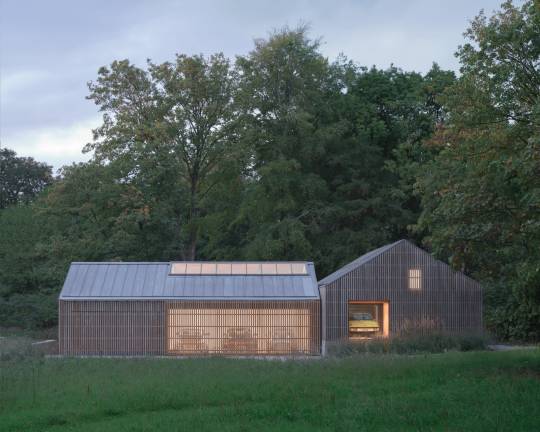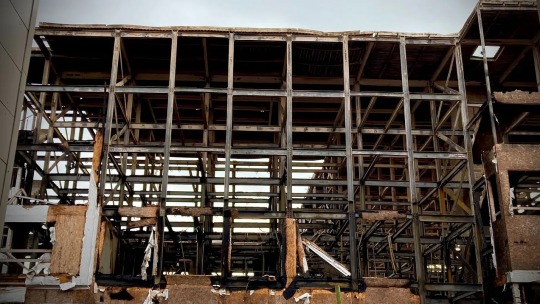#Insulated Roof and wall Cladding
Explore tagged Tumblr posts
Text
#westville group#cavity wall insulation#westville#home insulation#cladding#external insulation#roof insulation#ventilated home
0 notes
Text
Trusted ROCKWOOL Cladding Insulation by CSS CLADDING LTD
CSS CLADDING LTD offers reliable ROCKWOOL cladding insulation solutions designed for strong thermal, fire, and sound performance. Ideal for walls, roofs, and floors, products like the ROCKWOOL rainscreen duo slab, Timber Frame Slab, and Steel Frame Slab are perfect for new builds and extensions. They are lightweight, easy to install, and rated Euroclass A1 for fire safety. Suitable for ventilated façades, metal systems, and cavity fire stopping, ROCKWOOL insulation is a smart choice for long-lasting protection.
#ROCKWOOL Cladding#CSS CLADDING LTD#Insulation Panels#Fire Safety#Acoustic Insulation#Rainscreen Duo Slab#Wall and Roof Insulation#Timber Frame#Steel Frame
0 notes
Text

A BOY'S FIRST PEST
Kaz Brekker x Reader
Summary - Kaz Brekker thinks Per Haskell's daughter is a (very lovely) pest
Warnings - fem!reader, traumatraumatrauma, the woes of troubled youth, light mentions of blood and death, these bitches trauma bonded yo, could deviate some from canon, based more on book!kaz than show, NOT EDITED WE DIE LIKE MEN
Word Count - 2.0k
!MINORS DNI!
// masterlist // send me your thoughts // comments & reblogs appreciated! //





Everyone knows Kaz Brekker put his own money into fixing up the Slat.
He hired men to patch the leaky roof (though it still drips during a heavy rain) and put proper insulation in the walls (which keeps the house warm enough, even if it does nothing to muffle the noise of its occupants). He had all the doors fitted with working knobs (but easily picked locks) and ensured the kitchen was capable of making a warm meal (even if seriously doubted any of the Dregs knew how to cook).
And while he would never admit it aloud, Kaz was also the one who made sure there were always clean linens in every room (albeit the cheapest Ketterdam has to offer) and spare clothes in every closet (sizes ranging from wafer-thin to barrel-chested). In keeping, he also takes it upon himself to keep the bathing room stocked with a steady supply of toiletries (because if someone uses his toothbrush again, he’s going to kill everyone in this place and then himself).
Because of Kaz Brekker, the Slat was more than just a safe place to hole up. It was a haven, the closest thing many of the Dregs had to a home.
But it did, of course, have one enduring problem.
The pests.
Or, namely, the one pest—one that he could never quite exterminate (though the spider privy to the inner-workings of Kaz Brekker’s mind might argue the merit of replacing ‘could never’ with ‘would never’).
Per Haskell’s very annoying (and very lovely) daughter.

In the midst of Ketterdam’s hottest season, you find yourself lying sprawled on your back atop the dark sheets, clad in the skimpiest nightclothes you own: a matching set of black silk shorts and flowy, thin-strapped camisole. The air is thick and near stifling in the attic-bedroom, but you don’t mind it. You prefer being hot to cold, if only because the heavy weight of winter clothes makes you feel trapped, eliciting the urge to crawl straight from your skin.
When the door finally swings open, you eagerly push up onto your elbows.
Kaz doesn’t so much as spare a glance in your direction. He’s got one hand on his cane, the other shoving the door shut behind him as he limps toward his desk, guided by the bright moonlight spilling in from the muggy window.
Your shoulders slump, huffing out a breath. “Seriously? You’re not even gonna greet me?”
With his back turned to you, Kaz removes his hat and places it on the desk. He doesn’t look at you. “You’re in my room.”
“Yeah—so I was actually thinking something more along the lines of hello,” you drone, lips pursed. “Y’know, that thing normal people say when they see their friends.”
“We’re not friends.”
A hand flies to your chest, as if struck by his words. “Um, ouch? Rude. For your sake, I’m gonna pretend I didn’t hear that.”
Kaz tugs off his signature gloves and tosses them next to his hat. “I can always repeat it,” he says, so impassive you can’t tell if it’s a joke.
Knowing Kaz, you’re pretty sure it’s not.
You push up the rest of the way, scooting down to sit cross-legged at the end of his bed. It’s so much nicer than yours—the sheets softer, the mattress plusher, the smell so familiar and warm.
If it were up to you, you’d sleep in here every night.
And most nights, that’s exactly what you do.
“Would it kill you to be nice sometimes?” you ask.
“Not usually, no.” Kaz faces you, his weight leaned back against the desk, his cane propped against it. “But we both know you’re a special case.”
“Is that a compliment?”
“Not at all.”
Your bottom lip juts into a pout. “Has anyone ever told you you’re an asshole?”
Aside from the subtlest lift of his brows, Kaz’s expression remains vague and disinterested. “Regularly,” he deadpans, looking the image of austere melancholy.
Your laugh comes so sudden it sounds like a snort. “I should’ve guessed,” you nod, forever unphased by Kaz’s forbidding attitude.
This is the way things have always been between you. Ever since a surly twelve year old marched head-high into your father’s office to see if the Dregs needed a new grunt, oblivious to the girl beaming up at him from a lonely corner, weaving colorful scraps of thread into bracelets for the friends you’d yet to make.
Kaz Brekker is dark and foreboding while you’re bright and bubbly; he’s rude and standoffish while you’re sweet and flirtatious. Some may liken your relationship to oil and water, but you prefer thinking of it as a carefully crafted balance—a yin and yang sort of thing.
Kaz, on the other hand, would simply say you’re a thorn in his side.
Fortunately for yourself, you’re not an easily offended thorn.
The rickety floorboards creak as Kaz starts around the desk. His bare fingers trail along the varnished edge for support. His limp is always at its worst by this time of night, so you’re not surprised to see the flicker of relief that slips over him when he finally sinks into the chair.
“Have you ever considered that maybe you work too hard?” Your voice teeters on the edge of concern, tracing idle shapes against the sheets with your nails.
His answer is curt, and contradictory to the purple smudges beneath his eyes. “No.”
Fumbling with his cufflinks—simple, unadorned things—Kaz rolls his sleeves up to his elbows. Afterwards, he flips open the thick ledger laid before him, plucking up a pen and dipping it into an awaiting pot of ink.
Kaz keeps track of the Dregs expenses in his head—a skill you’ve always found most impressive, since you can hardly do a simple equation without scratch paper. Still, he keeps the physical record for the sake of having something to point to in case someone’s ever stupid enough to claim Dirtyhands flubbed the numbers.
As he works, boredom quickly becomes a chip on your shoulder.
Your legs unfurl, bare feet stretching toward the floor as you slip off the edge of the bed. Every step is purposeful, traipsing toward him with a look that’s not so unlike a cat readying to toy with its favorite mouse.
“Maybe we should take a holiday,” you suggest, your voice a soft trill.
One part of you expects to be ignored, the other to be shot down.
He lands somewhere in the middle.
“And go where? His eyes remain focused on the ledger, dark brows drawn tight in concentration. You envision numbers flashing before him, adding and subtracting at the steady pass of the nib scratching against parchment.
“I don’t know. Ravka, maybe?”
“Ravka?” It’s like the word tastes sour on his tongue. “Why?”
You stop just short of his desk, an answer instantly rapping at your mind. You quickly replace it with one that’s far less tragic. “I wouldn’t mind seeing Nikolai Lantsov with my own eyes,” you drawl. “Nina says he’s quite the looker, y’know.”
Kaz sits up a little straighter, shoulders pinned with newfound tension.
“Of course he is.” He seems to press the nib down harder, his disinterested tone bordering close to resentful. “He’s a prince—looking pretty is all they’re good for.”
Your head tilts. “Well, he’s actually a king now, so…”
There’s the briefest falter in the smooth motion of his jotting wrist. “I’m not taking you to Ravka so you can seduce the Lantsov bastard.”
“And why not?” You reach for the tip of his cane, still propped against the desk, skimming a finger over the crow’s head. “You think I can’t do it?”
The pen keeps on scratching, accented by the dull hum of the Slat’s perpetual motion—doors slamming, voices cackling. Your ego grows larger for every second Kaz stays silent, your satisfaction settling into a feline smirk.
Simply, yet firmly, Kaz eventually maintains, “We’re not going to Ravka.”
Your exhale is something over dramatic, laden with feigned disappointment as you huff, “Fine!” Kaz never looks up, continuing with the ledger.
Abandoning the crow’s head, you swipe one of Kaz’s abandoned gloves off the desk, fiddling with the smooth leather. Still recovering from their civil war, you imagine Ravka isn’t an ideal travel spot right now, anyway. Not unless someone has a morbid desire to tour the sites where Saints met their often-grisly ends, that is… Besides, for all Nina’s praise of the Lantsov king, you’ve never actually had a thing for blondes.
And yet—
“I really would like to go someday.” Your voice is hardly a whisper. Your other answer—tragic and rapping—crawls up your throat in a hoarse admission, “My mother was Ravkan.”
That persistent scratching finally comes to a sudden halt.
For the first time since he entered the room, Kaz looks up. There’s not a hint of pity in his eyes, though they gleam with solemn understanding. Your lips thin, pressing his glove tight to your chest.
In the winter of your fourteen birthday, you snuck into your father’s office and stole a full bottle of kvas. Dressed in clothes too light for the frigid weather, you sped up the crooked stairs to Kaz’s attic-bedroom, pleading until he begrudgingly agreed to join you on the moonlit roof. For a boy who claimed such an aversion to you, he was always doing things you asked—even if he’d griped the whole time. You both gagged after the first sip of hard liquor. After an hour or so, the full bottle had dwindled to just a drop, your tongues seeming to move with more freedom.
Neither of you had been prepared for the way the carbonated joy in your chests fizzled to something stagnant.
I don’t like being alone, you told him, fiddling with the frayed strings tied around your wrist, the friendship bracelets no one ever wanted. If I’m alone, it means I’m thinking, and if I’m thinking, it means my mother won’t stop dying.
You told him of the endless montage in your head. How at six years old, a walk along the Stave in your favorite winter coat ended with getting crushed beneath the weight of your mother’s last act of devotion, shielded by a body crumpled and crimson, shorn in the crossfire of unexpected gang violence. When you fell silent, Kaz drained the last drop of kvas and told you about a coffee shop near the Exchange. About a sickboat and a boy named Jordie, about a frosty harbor and an impossible swim that left him unable to bear the touch of another’s skin.
When neither of you had any soul left to bear, Kaz chucked the bottle off the roof. You don’t remember hearing it shatter, and maybe it never did. Maybe it hit some hapless pigeon and fractured his skull. Maybe it ceased to exist the moment it went over the edge. The bottle didn’t matter. Not to you. Not when Kaz Brekker reached for your wrist, leather-clad fingers gently tugging the bracelets off your wrist.
Don’t make a thing of this, he told you, stuffing them in his pocket. You’re still a pest.
But it was a thing. A strange, beautiful thing—and both of you knew it.
“Fine.” Kaz’s voice—the rasp of stone on stone—drags you back to the present. He sits the pen down beside the ledger, a strand of black hair swaying with the subtle shake of his head. “We’ll go to Ravka. You’ll seduce some sorry prince and live happily ever after in a gaudy palace. I’ll make my fortune snagging the Lantsov Emerald and use it to hire a proper bookkeeper. Deal?”
Your lips twitch, still hugging his glove to your chest. “King,” you correct him.
His eyes roll, but a flicker of something warm betrays his affection. “Pest,” he calls you, though it doesn’t sound like much of an insult.
“I imagine the Grand Palace has fine exterminators,” you muse.
“Then I suppose your marriage will be short-lived.”
“Will you save me, then?” Your heart leaps with the question, how it slips from your tongue before you can grasp it.
Kaz hesitates. Then—remarkably—smiles.
“Maybe.”


a/n - you know what they say. a bottle of kvas is never just a bottle of kvas, amirite
(☞ ͡° ͜ʖ ͡°)☞
anyways, i was procrastinating an essay and thought "lets write something with a somewhat ambiguous ending!" and voila, a boy's first pest is the product. now everyone say: lainie, go work on your original writing and stop writing so much fan fiction! (but i'm already thinking of a kaz smut drabble so) anyways, comments and reblogs much appreciated, i cry with joy every time someone actively interacts with my work so THANK YOU
#kaz brekker imagine#kaz brekker x reader#shadow and bone imagine#six of crows imagine#shadow and bone fanfic#s&b imagine#kaz brekker x fem!reader#kaz brekker x you#shadow and bone fic#shadow and bone x reader#six of crows x reader#six of crows imagines#crooked kingdom#six of crows#shadow and bone#s&b netflix#kaz brekker#six of crows fanfic#grishaverse imagine#grishaverse#freddy carter imagine#freddy carter
576 notes
·
View notes
Text

















Autobarn by Bindloss Dawes
The Autobarn is the realisation of our client's long-term dream to house his collection of classic German cars. The project is composed of two volumes: a clean, five-bay garage for everyday use and a taller workshop for repairs and future restoration projects.
Beyond satisfying this initial use, the project ambition was to create a flexible, 'long-life, loose-fit' building that could be used for a range of different uses. Currently it doubles up as event space, however the ambition is that the Autobarn could one day become a low-energy house.
Located on the outskirts of a small Somerset village, the project is set within the grounds of an eighteenth-century Grade 2 listed house. It replaces several haphazard outbuildings and consolidates their amenity into an elegant architectural proposal, nestled within a glade of mature trees.
The project's design references the language of neighbouring agricultural barns. As a practice we are interested in reassessing the rural vernacular, both for its contextual appropriateness and its lessons in low-cost, pragmatic design. As such, the Autobarn re-interprets simple forms and methods of construction, adapting more temporary, rudimentary methods into a robust and elegant paradigm for low-cost, rural architecture. Composed of a concrete base and steel framed structure, intermittent timber cladding and zinc metal roof, the Autobarn adapts barn typologies with varying levels of refinement. Consideration was also given to its weathering, with the natural zinc roof dulling to complement the silver patination of the sweet chestnut cladding.
Like many barns, permeability to light and air is controlled through a series of movable layers. First experienced as a closed solid mass, the barn walls open up via a number of doors, including an heroic 7m sliding timber screen. The intermittent timber slats of the screens create internal dappled light during the day, which is reversed at night as interior lighting illuminates the surrounding landscape. Internally the steel structure is expressed in an array of simple portal frames, with sustainably-sourced wood-fibre acoustic board forming internal wall and ceiling. The garage space is calm and gallery-like, while the workshop space presents a tougher, taller workshop, surrounded with concrete wainscotting and designed to accommodate a car lift.
The building's 'long-life/loose-fit' ambitions have meant that the insulation and energy performance exceed residential standards. Although thermostats are currently turned down for its current use, the building includes underfloor heating powered by an Air Source Heat Pump, as well as additional first fix services hidden behind the internal wall paneling for future conversion.
Construction started in November 2020 and was completed at the end of 2021, with the project effected by the global pandemic and building material inflation. Despite these challenges, and the inclusion of some one-off expensive items (such as the electric garage doors), the Autobarn was built for under £2,300 / m2. In tandem with high energy performance and the use of natural materials, it combines our studio's goal to combine beauty, affordability, and sustainability.
Design: Bindloss Dawes Location: Frome, United Kingdom Area: 165 m² Year: 2022 Photography: Building Narratives
#architecture#gable roofs#garages#barns#british barns#british garages#united kingdom#bindloss dawes#building narratives#interiors
34 notes
·
View notes
Text
A large fire was witnessed by residents of Liverpool Student Lettings accommodation in the early hours on January 27 2024. #LiverpoolEcho





Village of the damned: Inside the Fox Street fire
Special investigation: For years, Matt O'Donoghue was told about major problems at a controversial development in Everton. Then the dire predictions came true. By Matt O’Donoghue.
“Block D is an inferno right now”, the first message reads. “Look what’s been torched.” More follow. “Not sure how other blocks are faring, they’ve been evacuated.” Some have video or photos attached. “Seen this. I feel sick.” One simply reads: “Fox Street’s final chapter.”
Block D at the stalled residential development of Fox Street Village sits on the edge of Everton. It is ablaze, and a lot of people want me to know. As the firefighters battle to hold back the flames that threaten to leap from block to block, frantic calls, dramatic videos, and heartbreaking messages light up my phone screen. Many of those getting in touch are people I met over the past five years I’ve been reporting on the sorry saga of Fox Street Village. They’re all saying the same thing: “It was only a matter of time.”
“Something like this had to happen,” says Chris Burridge, who owns one of the Fox Street Village apartments as he surveys the damage. It’s Sunday, January 28th and the day after the fire. Steel girders are bent and buckled like roller coaster tracks; the metal cools and creaks, and loose material flaps in the wind. “There’s been no decent perimeter fence for some time, even though we’ve been reporting incidents. We were lucky Block B didn’t go up. The flames and heat were ferocious. Mersey Fire saved those buildings.”
Lucky indeed. Fox Street Village was originally intended to be a 400 apartment complex spread across four blocks that were to be four or five stories tall. But Block D was never completed and has remained an unfinished shell for the past five years. The rest of the site, on the other hand, is home to a number of residents. Had the fire spread there, it would have been catastrophic. Letting agents are on-site to support tenants and help with the clean up, while insurance brokers and risk assessors mill about around them. Lifts, heating, and water are soon back on. Black debris litters the ground and the flat roofs of the adjacent blocks, while clumps of burnt insulation and wood continue to drift from above.
A team from Residence 365, the company that manages the Village’s interior communal areas, is helping to get residents back into their homes. “Unfortunately, as the fire started to take hold, many residents in Block A failed to evacuate,” says Carolyn Delaney, Residence 365’s managing director. “Police had to force their way into every apartment to make sure that building was clear and everyone was safe. Those doors and frames will have to be repaired.”
Outside, Block B’s walls and windows are warped from where it faced the fire. The cladding is buckled and wavy, like bad icing on an overbaked cake. Most of the glass is cracked and broken, and window frames have bowed out of shape. The fire breaks under the cladding will have activated and expanded. There will need to be a lot of work to put things right.
“The grounds and estate management company are nowhere”, says an exasperated Burridge. The last he was told, a company called Xenia Estates Limited were responsible for looking after the outside areas. “It’s outrageous. They’ve sent nobody down here to help or make things safe.”
Kevin Robertson-Hale is a local campaigner who set up the action group Everton Together. He was shopping at the ASDA on the Breck Road when he first saw the black clouds rising above his community. He knew straight away what was likely to be burning. “It’s just a miracle that nobody’s been hurt,” he says. Although Block D was not a finished building, homeless people have been sleeping there and using it as a shelter. “The way the place went up, someone asleep would never have got out.” Kevin is horrified by what has happened, but certainly not surprised. “We’ve been saying for years that something was going to happen. Either someone was going to fall off and break their neck, or it was going to go up in flames.”
Beneath the debris and behind the spectacular videos, the plumes of smoke billowing out and up from the bare bones of blazing Block D, are hundreds of stories of loss and despair. To properly understand what went wrong at Fox Street Village, to learn why things must be fixed, we have to understand why they were broken in the first place.
Between 1971 and 1991, Everton’s population dropped by 60% as the area’s fortunes and prospects charted exactly the decline of the British Empire. As Liverpool’s docks fell silent, the huge warehouses and the factories like Tate and Lyle and British American Tobacco were closed. Thousands of jobs disappeared and the communities that once relied upon those goods shipped from all corners of the Empire ceased to exist. An urgent need to improve the area’s housing conditions, the crumbling Victorian tenements, led to slum clearance and demolition on a massive scale. Those once solid communities were broken up with families moved out and housed in places like Kirby, Runcorn and Skelmersdale. It was the perfect storm; shops closed, tower blocks were pulled down and the city’s terminal decline was hastened by Margaret Thatcher’s vicious attempts to starve the upstart council controlled by Hatton’s Militant Tendency into surrender.
Fox Street Village followed the same controversial funding model that has dogged similar schemes across the city, known as ‘fractional sales’. Buyers — many based overseas — are enticed with the promise of a good rent and a solid investment in return for paying a large part of the sale price upfront. But as countless investors at other stalled sites in Liverpool have discovered to their detriment, there’s little or no protection should things go wrong.
When Fox Street Village Limited collapsed into administration, in 2019, it owed creditors £10 million and the city council nearly £700,000. The council told us that an invoice for over half a million pounds remains unpaid but that the building’s new owners will have to pick up that tab. Meanwhile, £6 million that investors had paid out for Block D was instead spent on a new fifth building the developers had added to their scheme. A search of records show creditors who had paid for apartments in Block D came from Birkenhead to Beijing and all points in between. With no money left to complete the job, and no cash to settle their bills, the steel frame and internal walls made of wood have remained open to the elements. The freehold to the site was sold to Manchester-based property investment company SGL1 Limited in 2020 for a reported £1.6 million. The site was split and a separate company run by the same two directors as SGL1 but called SGL3, took over the unfinished Block D. A series of complex court cases followed as buyers battled to gain control and finish the scheme. By 2021, the architect’s original drawings for Block D had been rebranded as “Park View” to be marketed at a new group of buyers. A one bed studio in the unfinished wood and steel shell was being advertised for £85,000. The Post is unsure how many people bought into this new scheme or whether their money is protected.
“I bought a three-bedroom apartment that cost £135,000, which was a really good deal. With hindsight, almost too good to be true. I’ve been firefighting one problem after another since day one.” November 8th, 2023 and I am rattling along the M62 with Chris Burridge. “It doesn’t look that good,” Chris says with detached stoicism and monumental understatement as Fox Street Village Block D comes into view. “It would be funny, if it wasn’t so costly and dangerous.” Chris is one of the apartment owners who have been battling over an £80,000 bill to install a transformer that would safely reconnect their electricity to the grid. The builders left a hot-wired connection into the mains, which Chris says the buyers only found out about after they’d secured the right to manage some of the site. It was just the latest in a long line of hidden surprises that have revealed themselves over the five years since tenants moved in. “The biggest block, Block D, is just a shell that should have been finished years ago,” Chris tells me as we pull up alongside what looks like a building entirely made of wood and wrapped in tin foil. “There should have been one large, shared entrance area, an underground car park for 170 vehicles, shops, a cinema room with communal laundry, and a bike store. All of those amenities were what made this site so attractive.”
Chris pauses to re-imagine what could have been, before reality kicks back in. “None of that exists. What we’ve actually got are great apartments next to the rat-infested fire trap of a mess that is Block D.”
By Matt O’Donoghue
“Block D is an inferno right now”, the first message reads. “Look what’s been torched.” More follow. “Not sure how other blocks are faring, they’ve been evacuated.” Some have video or photos attached. “Seen this. I feel sick.” One simply reads: “Fox Street’s final chapter.”
Block D at the stalled residential development of Fox Street Village sits on the edge of Everton. It is ablaze, and a lot of people want me to know. As the firefighters battle to hold back the flames that threaten to leap from block to block, frantic calls, dramatic videos, and heartbreaking messages light up my phone screen. Many of those getting in touch are people I met over the past five years I’ve been reporting on the sorry saga of Fox Street Village. They’re all saying the same thing: “It was only a matter of time.”
Chris Burridge on Fox Street. Photo: Matt O’Donoghue.
“Something like this had to happen,” says Chris Burridge, who owns one of the Fox Street Village apartments as he surveys the damage. It’s Sunday, January 28th and the day after the fire. Steel girders are bent and buckled like roller coaster tracks; the metal cools and creaks, and loose material flaps in the wind. “There’s been no decent perimeter fence for some time, even though we’ve been reporting incidents. We were lucky Block B didn’t go up. The flames and heat were ferocious. Mersey Fire saved those buildings.”
Lucky indeed. Fox Street Village was originally intended to be a 400 apartment complex spread across four blocks that were to be four or five stories tall. But Block D was never completed and has remained an unfinished shell for the past five years. The rest of the site, on the other hand, is home to a number of residents. Had the fire spread there, it would have been catastrophic. Letting agents are on-site to support tenants and help with the clean up, while insurance brokers and risk assessors mill about around them. Lifts, heating, and water are soon back on. Black debris litters the ground and the flat roofs of the adjacent blocks, while clumps of burnt insulation and wood continue to drift from above.
A team from Residence 365, the company that manages the Village’s interior communal areas, is helping to get residents back into their homes. “Unfortunately, as the fire started to take hold, many residents in Block A failed to evacuate,” says Carolyn Delaney, Residence 365’s managing director. “Police had to force their way into every apartment to make sure that building was clear and everyone was safe. Those doors and frames will have to be repaired.”
Outside, Block B’s walls and windows are warped from where it faced the fire. The cladding is buckled and wavy, like bad icing on an overbaked cake. Most of the glass is cracked and broken, and window frames have bowed out of shape. The fire breaks under the cladding will have activated and expanded. There will need to be a lot of work to put things right.
“The grounds and estate management company are nowhere”, says an exasperated Burridge. The last he was told, a company called Xenia Estates Limited were responsible for looking after the outside areas. “It’s outrageous. They’ve sent nobody down here to help or make things safe.”
Subscribe
Kevin Robertson-Hale is a local campaigner who set up the action group Everton Together. He was shopping at the ASDA on the Breck Road when he first saw the black clouds rising above his community. He knew straight away what was likely to be burning. “It’s just a miracle that nobody’s been hurt,” he says. Although Block D was not a finished building, homeless people have been sleeping there and using it as a shelter. “The way the place went up, someone asleep would never have got out.” Kevin is horrified by what has happened, but certainly not surprised. “We’ve been saying for years that something was going to happen. Either someone was going to fall off and break their neck, or it was going to go up in flames.”
Beneath the debris and behind the spectacular videos, the plumes of smoke billowing out and up from the bare bones of blazing Block D, are hundreds of stories of loss and despair. To properly understand what went wrong at Fox Street Village, to learn why things must be fixed, we have to understand why they were broken in the first place.
The building on Fox Street. Photo: Chris Burridge
Between 1971 and 1991, Everton’s population dropped by 60% as the area’s fortunes and prospects charted exactly the decline of the British Empire. As Liverpool’s docks fell silent, the huge warehouses and the factories like Tate and Lyle and British American Tobacco were closed. Thousands of jobs disappeared and the communities that once relied upon those goods shipped from all corners of the Empire ceased to exist. An urgent need to improve the area’s housing conditions, the crumbling Victorian tenements, led to slum clearance and demolition on a massive scale. Those once solid communities were broken up with families moved out and housed in places like Kirby, Runcorn and Skelmersdale. It was the perfect storm; shops closed, tower blocks were pulled down and the city’s terminal decline was hastened by Margaret Thatcher’s vicious attempts to starve the upstart council controlled by Hatton’s Militant Tendency into surrender.
Stand on the edge of Fox Street today and look towards the gleaming glass skyscrapers and modern penthouses and it’s obvious, the regeneration that has breathed new life into other parts of Liverpool in recent years seems to run out of steam as it creeps towards this area’s streets. According to the last census, Everton West — where Fox Street Village sits — has the third highest numbers of children on free school meals. This neighbourhood has some of the poorest health indicators, including the lowest life expectancy, across the whole of the city.
As Liverpool’s reputation grew as a great place to study, the last decade has seen residential housing for the influx of students become the city’s short-term planning solution and a way to kickstart Everton’s economy.
Fox Street Village followed the same controversial funding model that has dogged similar schemes across the city, known as ‘fractional sales’. Buyers — many based overseas — are enticed with the promise of a good rent and a solid investment in return for paying a large part of the sale price upfront. But as countless investors at other stalled sites in Liverpool have discovered to their detriment, there’s little or no protection should things go wrong.
When Fox Street Village Limited collapsed into administration, in 2019, it owed creditors £10 million and the city council nearly £700,000. The council told us that an invoice for over half a million pounds remains unpaid but that the building’s new owners will have to pick up that tab. Meanwhile, £6 million that investors had paid out for Block D was instead spent on a new fifth building the developers had added to their scheme. A search of records show creditors who had paid for apartments in Block D came from Birkenhead to Beijing and all points in between. With no money left to complete the job, and no cash to settle their bills, the steel frame and internal walls made of wood have remained open to the elements. The freehold to the site was sold to Manchester-based property investment company SGL1 Limited in 2020 for a reported £1.6 million. The site was split and a separate company run by the same two directors as SGL1 but called SGL3, took over the unfinished Block D. A series of complex court cases followed as buyers battled to gain control and finish the scheme. By 2021, the architect’s original drawings for Block D had been rebranded as “Park View” to be marketed at a new group of buyers. A one bed studio in the unfinished wood and steel shell was being advertised for £85,000. The Post is unsure how many people bought into this new scheme or whether their money is protected.
“I bought a three-bedroom apartment that cost £135,000, which was a really good deal. With hindsight, almost too good to be true. I’ve been firefighting one problem after another since day one.” November 8th, 2023 and I am rattling along the M62 with Chris Burridge. “It doesn’t look that good,” Chris says with detached stoicism and monumental understatement as Fox Street Village Block D comes into view. “It would be funny, if it wasn’t so costly and dangerous.” Chris is one of the apartment owners who have been battling over an £80,000 bill to install a transformer that would safely reconnect their electricity to the grid. The builders left a hot-wired connection into the mains, which Chris says the buyers only found out about after they’d secured the right to manage some of the site. It was just the latest in a long line of hidden surprises that have revealed themselves over the five years since tenants moved in. “The biggest block, Block D, is just a shell that should have been finished years ago,” Chris tells me as we pull up alongside what looks like a building entirely made of wood and wrapped in tin foil. “There should have been one large, shared entrance area, an underground car park for 170 vehicles, shops, a cinema room with communal laundry, and a bike store. All of those amenities were what made this site so attractive.”
Chris pauses to re-imagine what could have been, before reality kicks back in. “None of that exists. What we’ve actually got are great apartments next to the rat-infested fire trap of a mess that is Block D.”
Residents in this area have been complaining to me about the rats for as long as I’ve been investigating Fox Street Village. Back in April 2019, I broke my first story on the slow-motion car crash that has taken place here — months of work as part of an ongoing investigation for ITV’s Granada Reports. Back then, tenant Ross Lowey told me on camera: “We don’t feel safe. Every time we come back round that corner, we expect to see flames coming out of it.” He was far from alone in his unhappy prophecy.
Six months before that first ITV News report, in November 2018, I had been on a separate investigation into how developers duck out of paying the millions they owed to their cash-strapped council. It suddenly took an unexpected twist. While I ploughed through a mountain of conflicting planning documents that link to this case, a buyer tipped me off that their building was about to be the first on Merseyside to be shut down and issued with a Prohibition Notice. It was the last-ditch resort for a city council that had run out of ideas on how to make this site safe. “Serious construction issues will contribute to the spread of fire,” the Prohibition Notice reads. “Fire will spread quickly and possibly unnoticed.”
Put simply, the problems that the buyers had uncovered at their completed flats were so severe that they put lives at risk. While Block D remained unfinished, three of the four blocks that people had already moved into were so dangerous that everyone would be forced to move out — immediately. Judge Lloyd would later brand the project “disgraceful” as she fined the developers £3,120 for breaching planning conditions. She expressed sympathy for the residents and investors who had been affected. Planning inspectors said the development was “poorly finished” and failed to meet standards. Those problems have cost hundreds of thousands of pounds to put right.
3
By Matt O’Donoghue
“Block D is an inferno right now”, the first message reads. “Look what’s been torched.” More follow. “Not sure how other blocks are faring, they’ve been evacuated.” Some have video or photos attached. “Seen this. I feel sick.” One simply reads: “Fox Street’s final chapter.”
Block D at the stalled residential development of Fox Street Village sits on the edge of Everton. It is ablaze, and a lot of people want me to know. As the firefighters battle to hold back the flames that threaten to leap from block to block, frantic calls, dramatic videos, and heartbreaking messages light up my phone screen. Many of those getting in touch are people I met over the past five years I’ve been reporting on the sorry saga of Fox Street Village. They’re all saying the same thing: “It was only a matter of time.”
Chris Burridge on Fox Street. Photo: Matt O’Donoghue.
“Something like this had to happen,” says Chris Burridge, who owns one of the Fox Street Village apartments as he surveys the damage. It’s Sunday, January 28th and the day after the fire. Steel girders are bent and buckled like roller coaster tracks; the metal cools and creaks, and loose material flaps in the wind. “There’s been no decent perimeter fence for some time, even though we’ve been reporting incidents. We were lucky Block B didn’t go up. The flames and heat were ferocious. Mersey Fire saved those buildings.”
Lucky indeed. Fox Street Village was originally intended to be a 400 apartment complex spread across four blocks that were to be four or five stories tall. But Block D was never completed and has remained an unfinished shell for the past five years. The rest of the site, on the other hand, is home to a number of residents. Had the fire spread there, it would have been catastrophic. Letting agents are on-site to support tenants and help with the clean up, while insurance brokers and risk assessors mill about around them. Lifts, heating, and water are soon back on. Black debris litters the ground and the flat roofs of the adjacent blocks, while clumps of burnt insulation and wood continue to drift from above.
A team from Residence 365, the company that manages the Village’s interior communal areas, is helping to get residents back into their homes. “Unfortunately, as the fire started to take hold, many residents in Block A failed to evacuate,” says Carolyn Delaney, Residence 365’s managing director. “Police had to force their way into every apartment to make sure that building was clear and everyone was safe. Those doors and frames will have to be repaired.”
Outside, Block B’s walls and windows are warped from where it faced the fire. The cladding is buckled and wavy, like bad icing on an overbaked cake. Most of the glass is cracked and broken, and window frames have bowed out of shape. The fire breaks under the cladding will have activated and expanded. There will need to be a lot of work to put things right.
“The grounds and estate management company are nowhere”, says an exasperated Burridge. The last he was told, a company called Xenia Estates Limited were responsible for looking after the outside areas. “It’s outrageous. They’ve sent nobody down here to help or make things safe.”
Subscribe
Kevin Robertson-Hale is a local campaigner who set up the action group Everton Together. He was shopping at the ASDA on the Breck Road when he first saw the black clouds rising above his community. He knew straight away what was likely to be burning. “It’s just a miracle that nobody’s been hurt,” he says. Although Block D was not a finished building, homeless people have been sleeping there and using it as a shelter. “The way the place went up, someone asleep would never have got out.” Kevin is horrified by what has happened, but certainly not surprised. “We’ve been saying for years that something was going to happen. Either someone was going to fall off and break their neck, or it was going to go up in flames.”
Beneath the debris and behind the spectacular videos, the plumes of smoke billowing out and up from the bare bones of blazing Block D, are hundreds of stories of loss and despair. To properly understand what went wrong at Fox Street Village, to learn why things must be fixed, we have to understand why they were broken in the first place.
The building on Fox Street. Photo: Chris Burridge
Between 1971 and 1991, Everton’s population dropped by 60% as the area’s fortunes and prospects charted exactly the decline of the British Empire. As Liverpool’s docks fell silent, the huge warehouses and the factories like Tate and Lyle and British American Tobacco were closed. Thousands of jobs disappeared and the communities that once relied upon those goods shipped from all corners of the Empire ceased to exist. An urgent need to improve the area’s housing conditions, the crumbling Victorian tenements, led to slum clearance and demolition on a massive scale. Those once solid communities were broken up with families moved out and housed in places like Kirby, Runcorn and Skelmersdale. It was the perfect storm; shops closed, tower blocks were pulled down and the city’s terminal decline was hastened by Margaret Thatcher’s vicious attempts to starve the upstart council controlled by Hatton’s Militant Tendency into surrender.
Stand on the edge of Fox Street today and look towards the gleaming glass skyscrapers and modern penthouses and it’s obvious, the regeneration that has breathed new life into other parts of Liverpool in recent years seems to run out of steam as it creeps towards this area’s streets. According to the last census, Everton West — where Fox Street Village sits — has the third highest numbers of children on free school meals. This neighbourhood has some of the poorest health indicators, including the lowest life expectancy, across the whole of the city.
As Liverpool’s reputation grew as a great place to study, the last decade has seen residential housing for the influx of students become the city’s short-term planning solution and a way to kickstart Everton’s economy.
Fox Street Village followed the same controversial funding model that has dogged similar schemes across the city, known as ‘fractional sales’. Buyers — many based overseas — are enticed with the promise of a good rent and a solid investment in return for paying a large part of the sale price upfront. But as countless investors at other stalled sites in Liverpool have discovered to their detriment, there’s little or no protection should things go wrong.
When Fox Street Village Limited collapsed into administration, in 2019, it owed creditors £10 million and the city council nearly £700,000. The council told us that an invoice for over half a million pounds remains unpaid but that the building’s new owners will have to pick up that tab. Meanwhile, £6 million that investors had paid out for Block D was instead spent on a new fifth building the developers had added to their scheme. A search of records show creditors who had paid for apartments in Block D came from Birkenhead to Beijing and all points in between. With no money left to complete the job, and no cash to settle their bills, the steel frame and internal walls made of wood have remained open to the elements. The freehold to the site was sold to Manchester-based property investment company SGL1 Limited in 2020 for a reported £1.6 million. The site was split and a separate company run by the same two directors as SGL1 but called SGL3, took over the unfinished Block D. A series of complex court cases followed as buyers battled to gain control and finish the scheme. By 2021, the architect’s original drawings for Block D had been rebranded as “Park View” to be marketed at a new group of buyers. A one bed studio in the unfinished wood and steel shell was being advertised for £85,000. The Post is unsure how many people bought into this new scheme or whether their money is protected.
Fox Street after the fire. Photo: Chris Burridge
“I bought a three-bedroom apartment that cost £135,000, which was a really good deal. With hindsight, almost too good to be true. I’ve been firefighting one problem after another since day one.” November 8th, 2023 and I am rattling along the M62 with Chris Burridge. “It doesn’t look that good,” Chris says with detached stoicism and monumental understatement as Fox Street Village Block D comes into view. “It would be funny, if it wasn’t so costly and dangerous.” Chris is one of the apartment owners who have been battling over an £80,000 bill to install a transformer that would safely reconnect their electricity to the grid. The builders left a hot-wired connection into the mains, which Chris says the buyers only found out about after they’d secured the right to manage some of the site. It was just the latest in a long line of hidden surprises that have revealed themselves over the five years since tenants moved in. “The biggest block, Block D, is just a shell that should have been finished years ago,” Chris tells me as we pull up alongside what looks like a building entirely made of wood and wrapped in tin foil. “There should have been one large, shared entrance area, an underground car park for 170 vehicles, shops, a cinema room with communal laundry, and a bike store. All of those amenities were what made this site so attractive.”
Chris pauses to re-imagine what could have been, before reality kicks back in. “None of that exists. What we’ve actually got are great apartments next to the rat-infested fire trap of a mess that is Block D.”
The author Matt O’Donoghue on ITV. Photo: ITC/IMDb.
Residents in this area have been complaining to me about the rats for as long as I’ve been investigating Fox Street Village. Back in April 2019, I broke my first story on the slow-motion car crash that has taken place here — months of work as part of an ongoing investigation for ITV’s Granada Reports. Back then, tenant Ross Lowey told me on camera: “We don’t feel safe. Every time we come back round that corner, we expect to see flames coming out of it.” He was far from alone in his unhappy prophecy.
Six months before that first ITV News report, in November 2018, I had been on a separate investigation into how developers duck out of paying the millions they owed to their cash-strapped council. It suddenly took an unexpected twist. While I ploughed through a mountain of conflicting planning documents that link to this case, a buyer tipped me off that their building was about to be the first on Merseyside to be shut down and issued with a Prohibition Notice. It was the last-ditch resort for a city council that had run out of ideas on how to make this site safe. “Serious construction issues will contribute to the spread of fire,” the Prohibition Notice reads. “Fire will spread quickly and possibly unnoticed.”
Put simply, the problems that the buyers had uncovered at their completed flats were so severe that they put lives at risk. While Block D remained unfinished, three of the four blocks that people had already moved into were so dangerous that everyone would be forced to move out — immediately. Judge Lloyd would later brand the project “disgraceful” as she fined the developers £3,120 for breaching planning conditions. She expressed sympathy for the residents and investors who had been affected. Planning inspectors said the development was “poorly finished” and failed to meet standards. Those problems have cost hundreds of thousands of pounds to put right.
Subscribe
The council say that it was only after the buildings were largely constructed that it became apparent there was a failure to comply with conditions or the plans that had been passed. When the new owners submitted another application to make up for the missing car park, a fresh deal was struck for them to pay towards a cycle route and parking scheme. But planning approval was refused when no money was forthcoming.
Two companies were involved in the development of Fox Street Village: Linmari Construction Limited and Fox Street Village Limited. Both were run by company director, Gary Howard. In 2013, Howard was left as the sole director of Fox Street Student Halls Limited after his business partner, Lee Carroll, was forced to step down. Carroll had been found guilty of being a gang master under legislation brought in to tackle labour exploitation after an investigation into a recruitment company that Carroll ran with John Howard. Carroll was banned from being a company director for 12 years.
While nothing should be inferred from Gary Howard’s previous business history, six companies where he was a director and shareholder have a County Court Judgement against them. Just like Fox Street Village Limited, seven firms that Howard also once helped run have gone into administration owing money to creditors — two of which were also residential developments in Liverpool designed for student living. We’ve been unable to contact Mr Howard for a comment.
“The frameworks that are supposed to deliver safe buildings, protect their owners and keep those inside safe are not up to the job,” says Dr Len Gibbs, whose doctoral thesis focused on the problems with unfinished developments in the Liverpool area.
That regulatory framework — to get a building through from an architect’s drawings to the point of being occupied — can be roughly broken down into two stages: planning and building control. The first part is strictly controlled by rules and regulations that must be met and followed to the letter. A council department controls the planning process, and everything has to be approved by a committee after a rigorous assessment by trained officers. Once it passes and everybody agrees that the buildings are what the council and community needs, the proposals are said to have ‘gained consent’.
When developers have their planning consent, a building control team comes on board to oversee every step of the construction. Site inspectors visit to approve stages such as the foundations and drains, and the relevant paperwork is filed with the city council to confirm everything has progressed according to the plans that were submitted and in accordance with the required regulations. In theory, these two functions operate independently but in support of one another to deliver a building that doesn’t kill the people who move in.
That’s something of a simplification, but these are incredibly complex areas that require years of training to properly understand. Only when every step has been followed can a completion certificate be issued against the building and each individual apartment. These final pieces of paper confirm that everything is up to standard and legally ready for tenants to move in. If all these steps are followed correctly, then a development of buildings that were once judged to be a threat to the lives of residents should never be occupied. Yet they were occupied.
#liverpoolstudentlettings#Liverpool student letting#2024#fire#Liverpool echo#fox street studios#video#viralpost#liverpool#student#Liverpool students#January 2024#blaze#merseyside#Fox Street Village#Matt O'Donoghue#itv
8 notes
·
View notes
Text
'I have been investigating the lost history of eelgrass as a building material. Eelgrass is a type of seagrass, that we often refer to as seaweed historically. In Denmark, it was used to thatch the roofs of the traditional Seaweed Houses on Læsø, but was also used as insulation and as mattress stuffing. In the US, it was also used as insulation in a product known as Cabot's Quilt. After moving to the Netherlands, I've also recently learned that eelgrass was used to prevent erosion in wierdijken, seaweed dikes. The more I find out about this material, the more excited I get, because it's been used so extensively around the world in buildings. Unfortunately, due to a wasting disease in the 1930s, a lot of this knowledge is lost, and eelgrass doesn't wash up in the same patterns, or in the same amount that it used to. Most of the time, it's left to rot on the beaches in vast amounts.
[...]
There are so many benefits to using eelgrass, if it's harvested locally. It's carbon neutral. It's as insulative as modern mineral wool. It's a fantastic acoustic dampener. It's rot resistant, when farmed properly. You have to leave it on a field to be rained on, to remove the outer salt layer and microalgae that cause the eelgrass to rot. There's been cases where people have opened the walls of their old New England homes, and found perfectly preserved eelgrass, hundreds of years later'

3 notes
·
View notes
Text
TRANSFORM YOUR HOME: LATEST EXTERIOR DESIGN TRENDS IN TAMIL NADU
Introduction :-
The exterior design of your home sets the first impression and reflects your style and personality. In Tamil Nadu, a state known for its rich cultural heritage and modern advancements, exterior design trends are evolving to blend tradition with contemporary aesthetics. Here’s a look at the latest
1. Fusion of Traditional and Modern Elements
One of the most popular trends in Tamil Nadu is the fusion of traditional and modern design elements. Homeowners are incorporating traditional features like intricate woodwork, terracotta tiles, and ornamental columns with sleek, modern lines and minimalist aesthetics.

Key Features:
Traditional Woodwork: Use of intricately carved wooden doors and windows.
Modern Minimalism: Clean lines and minimalist design for a balanced look.
Mixed Materials: Combination of materials like wood, glass, and concrete.
2. Sustainable and Eco-Friendly Designs
With a growing awareness of environmental issues, sustainable and eco-friendly exterior designs are gaining popularity. Homeowners are opting for materials and designs that reduce the environmental footprint of their homes.

Key Features:
Green Roofs: Roofs covered with vegetation to improve insulation and reduce heat.
Solar Panels: Integration of solar panels for energy efficiency.
Natural Materials: Use of locally sourced, sustainable materials like bamboo and reclaimed wood.
3. Outdoor Living Spaces
The trend of creating functional outdoor living spaces continues to thrive. Homeowners in Tamil Nadu are designing patios, decks, and gardens that serve as extensions of their indoor living areas.

Key Features:
Patios and Decks: Spacious outdoor areas with comfortable seating and dining spaces.
Outdoor Kitchens: Fully equipped kitchens for outdoor cooking and entertaining.
Landscaped Gardens: Professionally landscaped gardens with native plants and water features.
4. Vibrant Color Palettes
While neutral tones remain popular, there is a noticeable shift towards bolder and more vibrant color palettes. Homeowners are experimenting with colors to add personality and character to their exteriors.
Key Features:
Bold Accents: Brightly colored doors, shutters, and trims.
Natural Hues: Earthy tones like terracotta, olive green, and deep blue.
Contrasting Combinations: Use of contrasting colors to highlight architectural features.
5. Textured Finishes
Textured finishes add depth and interest to exterior walls. This trend involves using various techniques and materials to create unique textures that stand out.

Key Features:
Stone Cladding: Natural stone or stone-like materials for a rustic look.
Textured Paints: Specialty paints that create textured effects.
Stucco Finishes: Smooth or rough stucco finishes for a Mediterranean feel.
6. Large Windows and Glass Facades
Maximizing natural light and creating a seamless connection between indoor and outdoor spaces, large windows and glass facades are a major trend in Tamil Nadu.
Key Features:
Floor-to-Ceiling Windows: Expansive windows that offer unobstructed views.
Sliding Glass Doors: Large glass doors that open up to patios or gardens.
Glass Balconies: Balconies with glass railings for a modern touch.
7. Smart Home Integration
Smart home technology is becoming an integral part of exterior designs. Homeowners are incorporating advanced systems for security, lighting, and climate control that can be controlled remotely.

Key Features:
Smart Security Systems: Surveillance cameras and smart locks.
Automated Lighting: Smart lighting systems that can be programmed or controlled via smartphone.
Climate Control: Smart thermostats and sensors for efficient climate management.
Conclusion
Transforming your home with the latest exterior design trends in Tamil Nadu not only enhances its curb appeal but also adds value and functionality. Whether you prefer a fusion of traditional and modern elements, sustainable designs, or smart home technology, these trends offer a variety of options to suit your style and needs. Embrace these trends to create a beautiful and contemporary home that stands out in Tamil Nadu’s vibrant architectural landscape.
With regards
N Mohan
2 notes
·
View notes
Text
Color Coated Sheet Manufacturers in India: Enhancing PEB Structures with Strength and Style
In today’s construction landscape, Pre-Engineered Buildings (PEBs) are synonymous with speed, efficiency, and cost-effectiveness. However, beyond the steel frameworks and structural design, there’s a critical component that significantly impacts the performance and aesthetics of PEBs — Color Coated Sheets. These sheets not only protect the building but also elevate its visual appeal, and for that, color coated sheet manufacturers in India are playing a crucial role.
What are Color Coated Sheets?
Color coated sheets are steel or aluminum sheets that are pre-painted with high-quality paints and coatings. Used extensively in roofing and wall cladding, they provide:
Superior corrosion resistance
UV protection
Aesthetic value with a variety of color and texture options
Long life with minimal maintenance
They’re especially popular in industrial buildings, warehouses, commercial units, and residential applications.
Importance of Color Coated Sheets in PEB Structures
PEB manufacturers rely heavily on color coated sheets to complete the building envelope. These sheets serve as the outer skin of PEBs, protecting the internal structure from weather elements, while also aligning with brand identity and architectural design.
Key benefits include:
Quick installation and light weight
Energy efficiency with solar reflectivity
Customization in colors, thickness, and profiles
Compatibility with insulation systems
Role of Leading Color Coated Sheet Manufacturers in India
Top color coated sheet manufacturers in India ensure high-performance products through:
Advanced coating technologies (like polyester, SMP, PVDF)
Galvanized and Galvalume base metal options
Stringent quality control and IS-standard compliance
Custom orders for specific industrial and PEB applications
These manufacturers supply materials to PEB manufacturers, roofing contractors, and fabricators, making them an essential link in the construction ecosystem.
Applications of Color Coated Sheets in PEBs:
Roofing sheets for factories and godowns
Wall cladding for warehouses and cold storage
Canopies, facades, and partition panels
False ceilings and decorative exteriors
Choosing the Right Manufacturer
When selecting a color coated sheet manufacturer, consider:
Product warranty and life expectancy
Thickness and color range
Custom profiling capability
Delivery timelines and after-sales support
Trusted manufacturers ensure that your PEB project not only meets structural goals but also exceeds expectations in durability and appearance.
Conclusion:
In the world of Pre-Engineered Buildings, color coated sheets are more than just a covering — they are a functional, aesthetic, and protective element. Color coated sheet manufacturers in India are empowering the PEB industry with high-quality solutions that stand the test of time and climate. If you’re building with PEB, partner with the right sheet manufacturer to ensure your structure is both strong and striking.
Visit:- https://www.pebmanufacturers.in/color-coated-sheet.html
0 notes
Text
Sustainable Building Materials Transforming Modern Construction
Sustainability has become a key focus in the construction industry as environmental concerns intensify globally. Modern builders, architects, and homeowners increasingly seek building materials that reduce the carbon footprint, conserve natural resources, and improve energy efficiency, all while maintaining strength, durability, and aesthetic appeal.
In a rapidly urbanizing city like Bangalore, where construction activity is booming, adopting sustainable building materials is vital. These materials not only help reduce pollution and waste but often result in long-term cost savings due to improved insulation, durability, and lower maintenance.
Traditionally, concrete, steel, and fired bricks have been the backbone of construction in Bangalore and most Indian cities. While effective, these materials come with significant environmental costs: large energy consumption during production, depletion of natural resources, and carbon emissions. Sustainable alternatives or enhancements to conventional materials help reduce these impacts while delivering comparable or superior performance.
One of the most notable sustainable building materials gaining popularity is fly ash bricks. Fly ash is a byproduct of coal power plants, and using it to make bricks diverts large amounts of waste from landfills. Fly ash bricks are lighter than traditional clay bricks, provide better thermal insulation, and require less water during manufacturing. Moreover, these bricks have uniform size and shape, which accelerates construction and reduces mortar use.
Another eco-friendly option is compressed stabilized earth blocks (CSEB). Made from locally sourced soil mixed with stabilizers like cement or lime, these blocks reduce reliance on fired bricks and minimize transport emissions. CSEB has excellent thermal properties and can reduce the need for heating or cooling. Because earth blocks absorb and release moisture, they help regulate indoor humidity, improving occupant comfort.
Bamboo is another renewable material transforming construction practices. Fast-growing and requiring minimal pesticides or fertilizers, bamboo is strong and flexible, making it suitable for both structural and decorative uses. In Bangalore, some innovative projects incorporate bamboo in framing, flooring, and furniture. Bamboo’s tensile strength rivals steel, and its carbon sequestration capacity helps offset greenhouse gas emissions. Treated bamboo also resists pests and moisture, increasing its lifespan.
Recycled steel and metal products are increasingly integrated into modern construction as well. Steel is highly recyclable without losing strength, and using recycled steel reduces energy consumption by up to 75% compared to producing virgin steel. Many builders opt for steel framing or reinforcements made from recycled sources, cutting the embodied energy of the structure. Additionally, metal roofing and cladding made from recycled content improve durability and require less maintenance than traditional materials.
Wood from sustainably managed forests certified by organizations like FSC (Forest Stewardship Council) is another green material gaining traction. Using certified wood ensures harvesting practices that preserve biodiversity, protect water quality, and maintain ecosystem health. Engineered wood products such as cross-laminated timber (CLT) and laminated veneer lumber (LVL) combine wood layers to create strong panels used in walls, floors, and roofs. These engineered products reduce timber waste and allow for quicker assembly, reducing construction time.
Innovations in insulation materials also contribute to sustainable building design. Natural insulation products made from sheep’s wool, cork, cellulose (recycled paper), or hemp fibers offer effective thermal and acoustic properties while being biodegradable and non-toxic. Compared to synthetic foam insulations, natural products have a much lower environmental impact during manufacture and disposal.
Concrete is a cornerstone of construction but also one of the most carbon-intensive materials. To address this, new mixes incorporating supplementary cementitious materials like fly ash, slag, or silica fume reduce cement content without compromising strength. Additionally, geopolymer concrete, which replaces Portland cement with industrial byproducts activated chemically, emits up to 80% less CO₂. These alternatives are gaining traction in commercial and residential construction in Bangalore, where builders seek greener certifications.
Water conservation also factors into material selection. Porous paving materials such as permeable concrete or interlocking pavers allow rainwater to percolate into the ground rather than runoff, reducing flooding risks and replenishing groundwater. Using reclaimed wood, recycled aggregates, and salvaged materials reduces the demand for virgin resources, cutting overall environmental impact.
While choosing sustainable materials is essential, proper construction practices are equally critical. Minimizing waste during cutting, avoiding over-ordering, recycling site debris, and ensuring materials are sourced locally to reduce transportation emissions all contribute to greener construction.
The economic benefits of sustainable building materials should not be overlooked. Though some green materials have higher upfront costs, they often lead to savings through reduced energy consumption, lower maintenance, and longer lifespans. Buildings constructed with sustainable materials also tend to have better indoor air quality, contributing to occupant health and productivity.
In conclusion, sustainable building materials are redefining modern construction in Bangalore and beyond. By thoughtfully integrating fly ash bricks, earth blocks, bamboo, recycled steel, certified wood, natural insulation, and eco-friendly concrete alternatives, builders can reduce environmental impact without sacrificing performance or aesthetics. As consumer awareness grows and regulations evolve, the adoption of these materials is set to accelerate, paving the way for greener, healthier, and more resilient homes.
0 notes
Text
Trusted Manufacturer of High-Performance PUF Panels in Tiruchirappalli for Roofing & Wall Cladding
Mount is a leading manufacturer offering high-quality insulated roofing and wall cladding solutions across Tamil Nadu. We provide smart building materials that meet industrial, commercial, and cold storage requirements with speed and durability.
A key offering is our PUF sandwich panels in Tiruchirappalli, known for their excellent insulation, fire resistance, and load-bearing capacity. These panels are widely used in warehouses, factories, clean rooms, and prefabricated buildings. Designed with a rigid polyurethane core and metal sheet lamination, our panels ensure energy efficiency, structural stability, and ease of installation.
Whether you need thermal protection, reduced energy costs, or faster project delivery, our PUF panels are the ideal solution. Every panel is manufactured to precise specifications and tested for durability, weather resistance, and performance. At Mount, we also offer custom sizes and full technical support to meet your unique project demands.
Get in touch with Mount for superior PUF panel solutions tailored to your requirements.
📍 Address: SLR Complex, No. 57, Kottigepalya - Magadi Main Road, Bangalore, Karnataka – 560091 📞 +91 96060 83685 📩 [email protected] 🔗 https://x.com/Mountpeb 🔗 https://www.facebook.com/mountroofing 🔗 https://www.instagram.com/mountroofing/ 🔗 https://www.linkedin.com/company/mount-roofing-and-structures-pvt-ltd/ 🔗 https://www.youtube.com/@mountroofing
#Sandwich Roofing Puf Panels Manufacturers in Tiruchirappalli#Top Puf Roofing Sheet manufacturers in Tiruchirappalli Tamil nadu#Roofing Puf Panels Manufacturers in Tiruchirappalli#best Wall Panels Suppliers In Tiruchirappalli tamil nadu#Puf Sandwich Sheets In Tiruchirappalli tamil nadu
0 notes
Text
#westville group#cavity wall insulation#cladding#westville#home insulation#roof insulation#ventilated home#external insulation
0 notes
Text
WPC Louvers: The Next Wave of Contemporary Design
Introduction
WPC Louvers represents the next wave of contemporary design and functionality. By combining the natural beauty of wood with the strength properties of composite technology, WPC Louvers has become an industry phenomenon amongst architects, builders, and contractors.

We, at Frontage, offer a varied range of WPC Louvers to suit blended architectural needs. From exterior looks to designer fences and dividers, our louvers introduce beauty, functionality, and ecogen-friendliness.
Frontage's WPC Louvers Series
HYPO 33 Louvers
HYPO 33 Louvers introduce an extra color of modernity. With focus on neat appearances and fine performance, the louvers introduce aesthetic value and usability to every building. Key Features Modern city project design Good weather resistance Improve air circulation and energy efficiency
26mm Louvers
Functionally designed, 26mm Louvers can be applied to a number of applications such as wall cladding, fencing, and facades. With its narrow profile, easy installation with increased durability. Points of Note: Lightweight but resilient Weathers off adverse weather Glamorously designed to varied environments
5 Star Louvers
For high end, 5 Star Louvers offer the ultimate in sophistication. Sophisticated to nearly flawless quality for high-end usage, 5 Star Louvers unite style and functionality into one high-end product. Features: Top end finish with high desirability Boasts thermal insulation and energy efficiency Longevity of usage in severe conditions
Florence Louvers
Earth-inspired, Florence Louvers unite WPC performance and natural wood look and feel. Florence Louvers construct intelligent architectural elements that are as stunning as they are effective. Key Features: Authentic wood-like feel Weather Resistant and UV Resistant Ideal for both interior and exterior use
Why choose Frontage WPC Louvers?
Long Life Span
Our louvers are made of recycled material and are robust enough to handle harsh weather conditions and heavy usage and stay as stunning and maintenance-free for decades.
Environment Friendly Green Build
WPC Louvers, made of recycled material, are eco-friendly in nature compared to natural wood and can support green building projects.
Minimum Maintenance Needed
WPC Louvers will not infest, rot, and weather, and thus require minimal maintenance to be awesome.
Flexible Designs
In varying sizes, colors, and finishes, our louvers are merely integrated into any building construction.
Value-For-Gotten
In quality and refinement, WPC Louvers provide value previously unknown to construction projects of any size. Uses Facades: Incorporate building facades with solid and refined options. Ceiling Slopes: Incorporate roof slopes with sophistication and elegance. Partitions: Design functional and trendy indoor partitions. Ceilings: Shape interior space with depth and sophistication.
FAQs
Q1: Of what are WPC Louvers made?
A1: A combination of plastic and wood fibers, the best of both worlds.
Q2: Are WPC Louvers weather-resistant?
A2: Yes, UV-resistant, water-resistant, temperature-resistant, ideal for exterior use.
Q3: Can WPC Louvers be wood-look designed?
A3: Yes, of course! Our most of the designs have wood-like texture and finishing to provide that natural touch.
Q4: Are Frontage WPC Louvers customizable?
A4: Yes, we can design size, color, and texture to suit your special requirements.
Q5: How are WPC Louvers different from wood?
A5: WPC Louvers are more durable, low maintenance, pest-resistant, rot-resistant, and weather-resistant.
Q6: What is WPC Louvers maintenance?
A6: Bare minimum—just water occasionally with watered-down soap to maintain them freshly done.
Breathe New Life into Your Spaces with Frontage
Frontage WPC Louvers offer the perfect combination of style, durability, and sustainability. Residential or commercial application, our louvers offer the ultimate solution to elevate your architectural designs to new levels. Choose Frontage for enduring excellence. Meet our WPC Louvers, state-of-the-art decorations that not only add to the richness of beauty in your surroundings but also bring enduring, green solutions for modern living.
#lowmaintenance#exteriordesign#woodplasticcomposite#weatherresistant#ecofriendlydesign#durablelouvers#wpclouvers#innovativedesign#sustainablematerials#woodtexture#wpc louvers#exteriors#exterior#architecture#buildings#house design#outdoor louvers in delhi#outdoor louvers#best exterior louvers#exterior louvers in delhi#exterior louvers#wpc louvers in delhi#louvers in delhi#best louvers in delhi#aluminium louvers in delhi#front elevation#front elevation design
0 notes
Text
What is Building Elevation? Understanding the Basics of Architectural Elevation Design

When it comes to designing a home, office, or any structure, the term "building elevation" often comes up. But what does it mean? For architects, homeowners, and design students alike, understanding building elevation is crucial. Good elevation design goes beyond creating a beautiful façade; it combines form and function to make a building truly exceptional.
This blog will break down the concept of building elevation, explain why it is so important in architecture, and explore how it impacts aesthetics and functionality. We’ll also discuss types, key elements, and the tools that are revolutionizing elevation design.
What is Building Elevation?
At its core, building elevation refers to the vertical representation of a structure. While floor plans provide a bird's-eye view, elevations show the building’s face or profile from different sides. It’s essentially how a building looks from the outside.
Different Types of Views
Front Elevation: Often the most detailed, presenting the building's face or entry point.
Side Elevation: Offers a perspective of the building’s sides, revealing depth and roof slopes.
Rear Elevation: A simpler representation, often focused on function rather than aesthetics.
Sectional Elevation: Shows an internal vertical cut-through of the building, providing structural insights into walls, floors, and ceilings.
Elevation drawings are a window into the structure’s design, showing proportions, dimensions, and style. Whether it’s a minimalist villa or a colonial-style home, elevation design sets the tone.
Purpose of Elevation Design
Why is elevation design so valuable? Here are several reasons why this aspect of architecture matters tremendously.
1. Enhancing Aesthetics
Your building’s elevation is the first impression anyone gets of your home or structure. A thoughtfully designed elevation can elevate curb appeal and create lasting impressions, setting the tone for interiors too.
2. Selecting Materials
Planning materials and finishes becomes easier when working with a detailed elevation design. For example, it can clarify decisions about textures, cladding, window placements, and trims.
3. Visualizing Proportions
Elevation drawings help architects and homeowners understand the spatial arrangement and scale of the building. They provide clarity on the balance between height, width, and details.
4. Communication Bridge
For builders, contractors, and clients, elevation drawings act as a crucial communication tool. They guide construction teams by providing actionable plans and addressing specific requirements collaboratively.
Types of Building Elevations
Let's look deeper into the different types of elevation designs and their roles.
Front Elevation
The front elevation reveals the building’s face, capturing architectural detail, doors, and windows. It draws the most attention and is often the most decorated view.
Side Elevation
This view provides the building's depth and outlines roof shapes, slopes, and any external elements like balconies or staircases.
Rear Elevation
Focused on functionality, rear elevations often feature utility components like service doors, backyard patios, or ventilation.
Sectional Elevation
This cut-through view is essential for architects and engineers to study the internal structure. It highlights technical aspects, such as beam placements and insulation layers.
Key Elements in Elevation Drawings
Every great elevation drawing is made up of several components. Here are the key elements they often feature:
1. Doors and Windows
Doors and windows are pivotal to both design and energy efficiency. From sliding glass doors to symmetrical window alignments, these elements define a structure’s character.
2. Wall Treatments
Textures, brickwork patterns, and cladding options are brought to life in elevation drawings. They ensure the external walls align with the overall architectural style, whether modern or traditional.
3. Roof Design
From flat roofs to gabled ones, the roof's shape and inclination are essential details in the profile of any building.
4. Balconies and Projections
Balconies, railings, and overhangs add functionality and aesthetic value to a building’s design.
5. Dimensions and Scale
Accurate scaling helps all stakeholders understand the actual proportions of the building, from the tiniest eaves to the overarching roofline.
Tools and Technologies for Elevation Design
Gone are the days of exclusively working with hand-drawn sketches. Modern tools have revolutionized how elevation designs are created.
Traditional Hand Drawing
While traditional drafting is still valued for its artistic touch, it’s time-consuming compared to digital methods.
CAD Software
Computer-Aided Design (CAD) software like AutoCAD lets architects create precise and professional elevation drawings, offering incredible detail and precision.
3D Modeling
Tools like SketchUp, Revit, and Lumion bring elevations to life in 3D, allowing clients to visualize the building in its entirety.
AI-Powered Design Tools
AI tools such as Buildiyo are making waves by streamlining the design process. These platforms combine algorithms and data-driven insights to optimize elevation designs swiftly.
Why Good Elevation Design Matters
You might wonder, “Why is elevation design so critical for my project?” The answer lies in the interplay between aesthetics, functionality, and sustainability.
1. Enhancing Curb Appeal
A well-designed elevation attracts attention. If you're a homeowner in Chennai or anywhere else, finding the top architecture company in Chennai can help ensure your building stands out for all the right reasons.
2. Boosting Energy Efficiency
Good elevation design can improve ventilation and reduce external heat transfer. Strategic window placements, for instance, can enhance natural light while reducing energy bills.
3. Climate-Specific Design
For regions like India, elevation designs must often incorporate Vastu Shastra principles or adapt to specific climates. For modern homes, features like shaded verandas serve both traditional and practical purposes.
4. Increasing Property Value
If you’re planning a new construction, investing in expert elevation design can significantly raise your property value over time.
Popular Elevation Design Styles
Your building’s elevation is your canvas. Here are a few trending styles to inspire you.
Modern Elevation: Simple geometries, clean lines, and open spaces.
Contemporary: Mixes traditional and modern styles with experimental shapes and materials.
Colonial Style: Features symmetrical layouts, pillars, and detailed moldings for a timeless charm.
Mediterranean: Warm terracotta tones, stucco walls, and archways reflecting coastal vibes.
Minimalist: Less is more. White walls, sharp lines, and minimal decoration identify this style.
Designing Your Dream Elevation
Understanding building elevations is key to creating spaces that are as functional as they are beautiful. Elevation drawings bring your architectural vision to life, ensuring harmony between aesthetics, practicality, and environmental considerations.
If you’re embarking on a new home construction or interior design project and want to collaborate with experts, look no further. Consult the top architecture company in Chennai or explore AI-powered tools to bring your dream building elevation to life effortlessly.
Architectural excellence starts here. Are you ready to design your masterpiece?
0 notes
Text
Discover High-Quality Construction Materials from KM Traders Madurai for Your Transformative Projects
When it comes to premium building materials, KM Traders Madurai leads the way with an impressive range of UPVC Accessories in Madurai and durable Decking Sheets in Madurai. Our commitment to quality, affordability, and innovation makes us the preferred choice for contractors, architects, and homebuilders across India and beyond. Whether your project involves modern roofing or stylish wall finishes, our products are designed to deliver strength and elegance.
1. Superior Quality UPVC Accessories in Madurai for Long-Lasting Performance
At KM Traders Madurai, we offer an extensive variety of UPVC Accessories in Madurai known for their durability and low maintenance. UPVC components provide excellent resistance to weather, corrosion, and termites, making them ideal for windows, doors, and plumbing systems in transformative building projects.
Our UPVC accessories come in multiple sizes and designs to suit contemporary architectural needs, ensuring your structures remain sturdy while maintaining aesthetic appeal. As trusted suppliers of UPVC Accessories in Madurai, we guarantee premium quality that supports sustainable construction.
2. Innovative Decking Sheets in Madurai for Stylish Outdoor Spaces
Transform your outdoor living areas with the top-rated Decking Sheets in Madurai available at KM Traders. Our decking sheets are crafted with advanced materials that resist water, fading, and insect damage. They offer an eco-friendly alternative to traditional wood, requiring less maintenance while delivering a natural look.
With a variety of textures, colors, and finishes, our Decking Sheets in Madurai cater to diverse design preferences. Perfect for patios, gardens, and balconies, these sheets elevate the functionality and beauty of any outdoor space, supporting your vision of a transformative travel-inspired home.
3. Durable Aluminium Sheets in Madurai for Versatile Applications
Our premium Aluminium Sheets in Madurai are engineered for robustness, corrosion resistance, and lightweight handling. Aluminium sheets are widely used in roofing, cladding, signage, and furniture manufacturing due to their versatility and eco-friendly nature.
At KM Traders, we supply aluminium sheets that meet global quality standards. The Aluminium Sheets in Madurai in our inventory are available in multiple grades and thicknesses, making them suitable for various industrial and residential applications. Choose us as your reliable partner for aluminium supplies that empower your innovative construction ideas.
4. Efficient Roofing Insulations in Madurai for Energy-Saving Buildings
Proper insulation is crucial for sustainable building design. KM Traders Madurai brings you high-performance Roofing Insulations in Madurai that reduce heat transfer, enhance energy efficiency, and improve indoor comfort. Our roofing insulation materials are ideal for commercial complexes, homes, and industrial units aiming to minimize their carbon footprint.
Our product range includes foam boards, reflective insulation, and other advanced materials tailored to different roofing systems. As trusted providers of Roofing Insulations in Madurai, we support your efforts in creating environmentally responsible, energy-efficient buildings.
5. Versatile PUF Roofing Panels and Wall Cladding Panels in Madurai for Modern Architecture
KM Traders proudly supplies high-quality PUF Roofing Panels in Madurai, which combine thermal insulation and structural strength. These panels are perfect for factories, warehouses, and cold storage facilities needing reliable temperature control.
Additionally, our Wall Cladding Panels in Madurai add a stylish and protective layer to building exteriors and interiors. Available in various finishes and materials, these panels resist weather damage and enhance the architectural aesthetics.
Our PUF Roofing Panels in Madurai and Wall Cladding Panels in Madurai are manufactured to comply with international quality and safety standards, making them essential for transformative construction projects.
KM Traders Madurai is your one-stop supplier for premium building materials like UPVC Accessories in Madurai, Decking Sheets in Madurai, Aluminium Sheets in Madurai, Roofing Insulations in Madurai, PUF Roofing Panels in Madurai, and Wall Cladding Panels in Madurai. Our products are trusted by builders across India and worldwide for their quality, innovation, and reliability. Partner with KM Traders to realize your next transformative building project with ease and confidence.
for more details: https://kmtradersmadurai.com/ +91-95000 91184 +91-9500447526

0 notes
Text
Things Investors Should Know About Sandwich Panel Manufacturers
Sandwich panels have become a cornerstone of modern construction due to their durability, thermal efficiency, and quick installation. As the demand grows across industries such as warehousing, logistics, cold storage, prefab buildings, and industrial facilities, investors are increasingly drawn to this segment. However, before diving in, it’s important to understand what goes into the business of sandwich panel manufacturing and how to evaluate a reliable sandwich panel manufacturer.
1. What Are Sandwich Panels?
Sandwich panels are composite structures made of two outer metal sheets and a core material in between, typically polyurethane (PU), polyisocyanurate (PIR), or rockwool. These panels are extensively used in roofing, cladding, and insulation of industrial and commercial structures. Their high strength-to-weight ratio, thermal insulation properties, and fire resistance make them an efficient building material in a cost-conscious construction market.
2. Industry Trends Driving Demand
Several macro and micro trends contribute to the increasing demand for sandwich panels:
Rapid urbanization in emerging economies
Increased awareness of energy-efficient buildings
Growth in cold chain logistics and warehousing
Prefabricated construction popularity for faster project turnaround
These trends make the sandwich panel sector lucrative for long-term investments.
3. Evaluating a Sandwich Panel Manufacturer
When considering a sandwich panel manufacturer, look beyond the basic product offering. Key evaluation factors include:
Manufacturing capacity: A reliable manufacturer should have modern, automated production lines capable of handling large-scale orders with precision.
Product range: Top manufacturers offer multiple core options (PU, PIR, rockwool), varied thicknesses, and custom profiles for walls, roofs, and ceilings.
Quality certifications: ISO certifications, fire resistance ratings, and compliance with international standards are crucial indicators of product reliability.
Turnaround time: Speed of manufacturing and on-site delivery timelines can impact project schedules significantly.
Technical support: Manufacturers who provide installation guidance and engineering support add considerable value.
4. Cost Considerations: Sandwich Panel Walls Price
Understanding pricing is essential for budgeting and ROI calculations. The Sandwich Panel walls price can vary based on:
Core material: PU and PIR panels are more expensive due to better insulation, while EPS panels are cost-effective.
Panel thickness: Thicker panels offer better thermal performance but increase costs.
Surface coating: Galvanized or pre-painted metal sheets impact durability and aesthetics, influencing the price.
Customization: Color, profile, fire resistance, and waterproofing features add to the final cost.
Investors should compare quotes based on total lifecycle value rather than just initial procurement costs. Long-term energy savings and lower maintenance costs often justify a slightly higher upfront investment.
5. Sustainability and Innovation
Modern sandwich panel manufacturers are moving towards eco-friendly production processes and recyclable materials. Innovations such as halogen-free fire retardants, green foam insulation, and solar-integrated panels offer competitive advantages and align with global ESG (Environmental, Social, Governance) trends. These sustainability factors increasingly affect investor interest and customer buying behavior.
6. Market Entry Considerations
For investors aiming to enter the market or form partnerships, here are some strategic steps:
Market research: Understand local regulations, building codes, and industry verticals with high demand.
Technology partnerships: Collaborate with R&D-focused manufacturers who are constantly innovating.
Scalability: Choose manufacturing partners who can scale operations with growing project sizes.
Distribution and logistics: Efficient supply chain operations ensure competitive pricing and reliable delivery.
Conclusion
TSSC Group is the leading sandwich panel manufacturer in the Middle East with a robust reputation built on decades of engineering excellence and technological innovation. We specialize in high-quality insulated panels, offering a wide range of core options and thickness configurations to meet diverse building requirements. Whether you are concerned about fire resistance, insulation performance, or durability—TSSC delivers.
With competitive Sandwich Panel walls price, unmatched customer support, and a strong focus on sustainable building solutions, TSSC Group continues to be the preferred partner for developers, contractors, and investors across the region. Our in-house R&D and cutting-edge facilities ensure that every product meets the highest international standards. Partner with TSSC Group for dependable quality and long-term value.
0 notes
Text
Color Coated Sheet Manufacturers in India: The Backbone of Modern PEB Structures
Introduction: In the realm of Pre-Engineered Buildings (PEBs), every component plays a vital role in ensuring strength, aesthetics, and durability. Among these, color coated sheets are more than just a visual element—they offer protection, insulation, and structural integrity. With growing demand in industrial and commercial construction, India has witnessed a surge in top-tier color coated sheet manufacturers in india who are powering the rise of modern steel buildings.
What Are Color Coated Sheets? Color coated sheets are steel or metal sheets that are coated with color using advanced painting technologies. These coatings not only enhance the appearance of buildings but also protect against corrosion, extreme weather, and wear over time. These sheets are widely used in roofing, cladding, and walling in PEB structures.
Importance in PEB Construction: For PEB manufacturers, color coated sheets are a go-to solution for:
Weather Resistance: Provides protection from rain, sun, and industrial pollutants.
Enhanced Aesthetics: Available in multiple colors and finishes, giving buildings a modern, professional look.
Thermal Insulation: Helps maintain temperature control within the structure.
Low Maintenance: Coated surfaces reduce the need for frequent repairs or repainting.
Environment-Friendly: Many manufacturers offer recyclable and energy-efficient options.
Key Features to Look for in a Color Coated Sheet Manufacturer:
Premium Raw Material – High-grade steel base for long life.
Consistent Coating Quality – Uniform paint application with corrosion resistance.
Variety of Profiles and Colors – Custom options to suit different PEB designs.
Compliance with Industry Standards – IS 14246 and international specifications.
Nationwide Distribution Network – Ensures timely delivery for PEB projects.
How They Support PEB Manufacturers: PEB manufacturers often partner with reputed color coated sheet suppliers to ensure their buildings meet not only structural but also aesthetic and functional standards. A good sheet manufacturer enables faster fabrication, better customization, and integration with the PEB design process. This synergy between color coated sheet suppliers and PEB builders is critical for delivering high-quality turnkey projects.
Leading Applications in PEB:
Factory Sheds
Warehouses
Cold Storages
Retail and Commercial Buildings
Airport Terminals
Institutional Facilities
Conclusion: As India embraces fast, efficient, and sustainable building solutions, the demand for high-performance color coated sheets continues to rise. Backed by innovation and quality assurance, color coated sheet manufacturers in India are enabling PEB manufacturers to deliver robust and visually appealing infrastructure across sectors. If you're planning a steel building project, make sure your sheet supplier is as strong and reliable as the structure you're aiming to build.
Visit:- https://www.pebmanufacturers.in/color-coated-sheet.html
0 notes